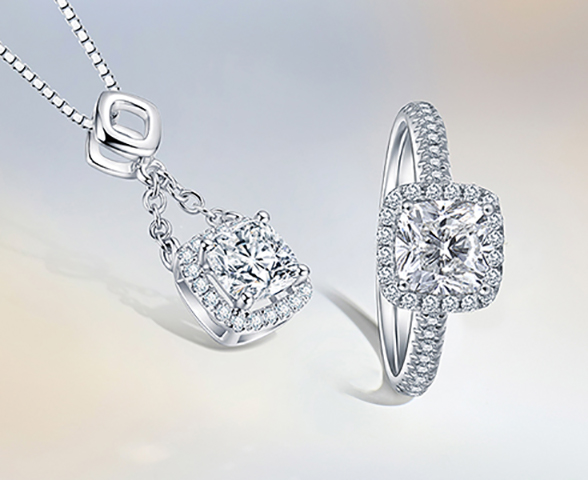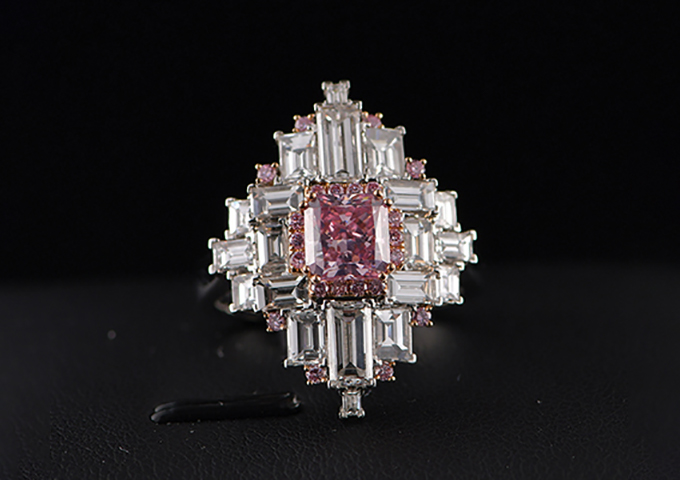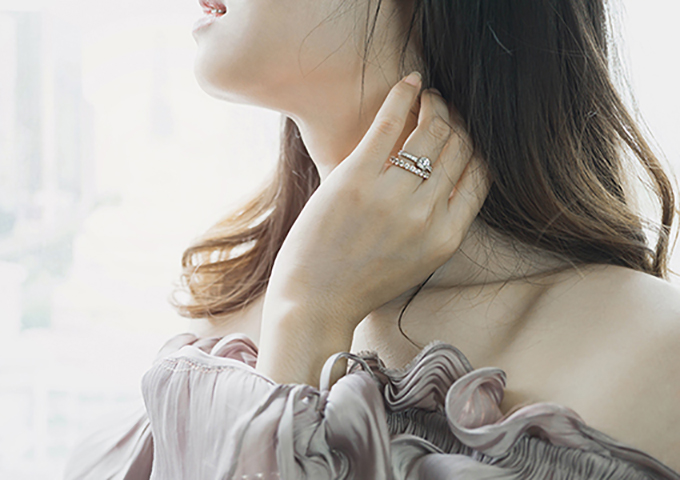With the Covid-19 pandemic effectively under control in China, demand for diamonds is on the rise, with all indications pointing to sustained growth as the market adjusts to post-lockdown consumer preferences.
The first half of 2020 bore the brunt of the pandemic’s impact on diamond imports and retail in China. The second half made up for earlier losses, rallying the year to a respectable finish. Recovery continued this year, with import and retail numbers registering a healthy bounce in the first seven months.
Net polished imports at the Shanghai Diamond Exchange (SDE) from January to July 2021 reached around US$1.84 billion, surpassing total imports in 2020 and recording a nearly 52 per cent hike over the same period in 2019. Given the current growth momentum, SDE forecasts that annual polished diamond imports this year could exceed 2018’s previous record high of US$2.78 billion.
SDE president Lin Qiang attributed the substantial growth in diamond imports to the rapid recovery of the Chinese economy, specifically the “release of consumption power restrained by the pandemic and the appreciation of the RMB, which offset diamond price increases in US dollar terms.” China’s diamond imports had been steadily growing since SDE’s establishment in 2000, registering an average annual compound growth rate of 26 per cent till 2018. The latest figures indicate that China’s diamond market is back on a normal
growth track.
Anti-smuggling and anti-money laundering initiatives initiated by the Chinese government likewise strengthened the country’s diamond market, Lin said.
In September 2020, Chinese customs authorities spearheaded a nationwide campaign to crack down on diamond smuggling, involving RMB5.9 billion (US$855 million) worth of goods. Around 150 people were detained in connection to the campaign. The fight against smuggling continued in 2021.
The carat weight and number of diamonds imported through SDE increased substantially due to the increase in demand and the anti-smuggling initiatives. Membership applications to SDE likewise surged, since the bourse is China’s only gateway for importing diamonds under a favourable tax policy.
Rough diamond imports at SDE nearly doubled from January to June 2021, when compared to the same period in 2019. The total number of SDE members increased to 386, more than half of which are foreign-funded companies.
Shanghai Diamond Trade Association President Pan Bin welcomed the government’s tough stance on illegal activities. “Smuggling has always been a threat to legitimate business. Smuggled diamonds are sold at a lower price and create unfair competition. Though prices may be lower, illegal goods do not have official invoices, leaving consumers largely unprotected in case of problems. The crackdown on smuggling creates a level playing field and a healthy market environment,” said Pan, who is also the director and general manager of Shanghai Lao Feng Xiang Diamond Processing Center Co Ltd, the diamond department of leading Chinese jeweller Lao Feng Xiang.
Market outlook
Favourable economic conditions in China likewise bode well for diamond sales. Consumption, exports and investment are the growth engines of the country’s Gross Domestic Product (GDP).
In 2020, the government started implementing its Dual Circulation strategy that stimulates domestic consumption and reduces dependence on exports. Despite the pandemic, consumption contributed 54.3 per cent of total GDP growth in 2020. The government now intends to triple or quadruple China’s 2020 GDP per capita of US$11,000 by 2035.
With China projecting moderate economic growth of 5 per cent to 6 per cent in the coming years, the country’s diamond market is likely to achieve another decade of growth.
KGK Group Vice Chairman Sanjay Kothari is confident China’s diamond market will remain stable moving forward. “The strong rebound since the beginning of 2021 indicates that the economic foundation and fundamental factors underpinning the development of China’s diamond market remain intact, thus validating the steady growth of China’s diamond imports,” he said.
Business has also improved this year for diamond wholesaler and SDE member Huabi (HB) Diamond. Wholesale orders in the first six months doubled over the same period in 2020 but are slightly lower than 2018 and 2019 levels year on year, said company president Lydia Geng.
“The bigger retailers are gravitating towards bespoke jewellery orders to reduce their own inventories,” she revealed. “Wholesale demand for round diamonds above 0.30 carat has increased significantly, but sales for stones below 0.30 carat have gone down. Round diamonds of 1.50 to 2 carats are highly sought after as well as fancy shapes over 2 carats.”
Apart from traditional retailers, solid demand is coming from smaller designer studios and jewellery salons that specialise in customised orders, Geng noted. Online channels perform well, too. “In the latter part of the year, we plan to provide more goods suitable for designer pieces, especially in the 0.50-carat, 0.70-carat and 1-carat round categories, and fancy shapes over 3 carats,” she disclosed.
The Indian connection
According to the Gem & Jewellery Export Promotion Council (GJEPC), 14 out of 15 diamonds are polished in India. The health of China’s diamond trade is thus closely entwined with India’s supply situation. Polished diamonds from India are shipped to the mainland directly or through Hong Kong.
India had been enjoying a surge in demand for polished diamonds and diamond-studded jewellery exports after the initial lockdowns last year, GJEPC said. Local demand for diamond jewellery also picked up in the second half of 2020 through to February 2021.
From January to March 2021, production was in full swing to meet demand. Polished output however dropped 20 to 25 per cent in April and May as the country grappled with its second wave of Covid-19 that forced lockdowns and labour shortages. New orders were put on hold due to logistical restrictions on goods and people.
Kothari said, “Chinese manufacturers were raring to resume production in March and April but due to the suspension of diamond production in India, there was a shortfall in supply.”
As the second wave eases and vaccination drives gain momentum, India’s diamond production is revving up again. GJEPC expects the surge in demand for jewellery in India to continue through to March 2022, barring new outbreaks.
Sanjay Shah, convener of GJEPC’s Diamond Panel, noted a sustainable increase in demand for diamond jewellery in China. Stimulus packages, pent-up demand for luxury goods and increased domestic spending in the absence of international travel have lifted retail sales since the second half of 2020, he said. The slowdown in Hong Kong also unlocked more opportunities for leading retailers to open new stores in mainland China.
“We continue to see robust demand from China for the rest of 2021,” said Shah, who expects polished prices to remain firm due to shortages of rough in the global market.
Retail rebound
China’s jewellery retail market is on the road to recovery as well, with diamond jewellery playing a significant role in the rebound.
Jewellery retail sales from January to July 2021 for a key sample of jewellers with annual sales over RMB5 million (US$775,000) amounted to RMB173 billion (around US$26.8 billion), a nearly 53 per cent year-on-year increase, data from China’s National Statistics Bureau showed.
According to Bain’s Global Diamond Industry 2021 report, China’s diamond retail market is estimated to have declined by 6 per cent in 2020. It is however expected to recover more rapidly than other parts of the world. In the fourth quarter of 2020, it grew 15 per cent to 20 per cent, compared to the same period in 2019.
While plain gold jewellery remains the bestselling category in China, diamond jewellery is steadily gaining ground, another study revealed. The 2020 China Jewellery Industry Development Report by the Foundation of the Gems & Jewelry Trade Association of China (GAC) indicated that total jewellery retail sales in China last year came up to approximately RMB610 billion (US$88.44 billion).
Plain gold jewellery accounted for 55.7 per cent of sales, followed by jadeite jewellery with a 14.8 per cent market share and diamond jewellery with 13.1 per cent. These three categories combined made up more than 80 per cent of China’s jewellery retail sales, the GAC report revealed.
According to Pan, diamond jewellery accounted for 10 per cent of Lao Feng Xiang’s RMB51.7 billion (US$7.5 billion) retail sales in 2020 but comprised 90 per cent of gem-studded jewellery sales.
Lao Feng Xiang is targeting RMB60 billion (US$8.7 billion) in total jewellery retail sales this year and expects diamond jewellery sales to return to record-high levels attained in 2019.
Growth drivers
The wedding market, once seriously affected by the pandemic, has also achieved a quick recovery since the beginning of 2021. Over 2.1 million couples registered for marriage certificates in the first quarter, 37 per cent more than the same period in 2020.
“Weddings remain the backbone of diamond consumption in China,” remarked Stone Xu, chairman of leading diamond jewellery retailer Zbird.
The wedding market prefers 1-carat diamonds as well as stones in the 0.30-carat to 0.50-carat range, which accounts for around 75 per cent of Zbird’s total sales. Some 65 per cent of Zbird’s sales in this customer segment are for diamonds in F-H colour, while 80 per cent of its wedding-related sales are for VS1 to SI1 stones, Xu shared.
Pan likewise underscores the importance of the wedding market to the diamond jewellery retail sector. Wedding bands with small diamonds are always popular buys at Lao Feng Xiang. When it comes to bigger diamonds, 0.50- to 1-carat stones move well, Pan continued. A 1-carat diamond commands around RMB40,000 (US$5,800) to RMB50,000 (US$7,250) at promotional events such as wedding shows. This fits nicely in the budget of newlyweds in Shanghai. Meanwhile, diamonds of 2 carats and up are purchased mostly by middle-aged consumers.
Zbird’s Xu also pointed to increasingly diversified consumer preferences for diamonds. In addition to traditional round diamonds, more Chinese consumers are seeking fancy-shaped diamonds such as cushion and princess cuts. Moreover, consumers who already own a diamond now tend to buy diamond jewellery as a gift for loved ones to commemorate important milestones such as wedding anniversaries. Some of them would consider gifting fancy colour diamonds. Mid-priced yellow diamonds are extremely popular for these occasions, according to Xu.
Retail sales of diamond jewellery will get a further boost from upcoming shopping seasons and festivals. Demand is poised to soar during Golden September and Silver October, the traditional wedding peak seasons. Double 11 or Single’s Day on November 11, Christmas and New Year likewise draw diamond sales.
Structural shifts
Evolving market segments and channels present fresh opportunities for China’s diamond trade.
The Natural Diamond Council (NDC) is training its sights on China’s millennial consumers, who respond better to digital engagement, said Mabel Wong McCormick, NDC's managing director for Greater China.
“The younger generation of consumers are enthusiastic about novelty and innovation, willing to try new things, less price-sensitive and head online for information. To build trust and better interact with them, we need to make good use of digital platforms, embrace social media channels and provide consumers with a seamless offline-online experience,” said McCormick.
NDC has adjusted its communications strategies to form a social media matrix revolving around the Only Natural Diamonds site and social platforms WeChat, Weibo and Red to cater to younger consumers. It is also working with retailers to highlight the value of natural diamonds among their customers. NDC’s first strategic retail partner in mainland China is Chow Tai Fook Jewellery Group.
KGK’s Kothari cites the rise of online sales activities
as the pandemic’s far-reaching impact on China’s diamond sector. Retail of goods through digital initiatives such as podcasts, WeChat, Weibo, TikTok, Bilibili, Taobao, Tmall and VIP membership activities has seen unprecedented growth, he said.
Online sales of diamond jewellery remain relatively low compared to other luxury goods though. To successfully shift to digital channels, Kothari said the industry needed to improve consumer trust by providing diamond certificates, warranties and reviews. Online sales should become more convenient through free delivery and return or “try before paying” arrangements. Additional discounts may also be provided for online purchases.
“Retailers that engage with new brand ambassadors, Key Opinion Leaders (KOLs) and China’s Key Opinion Consumers (KOCs) will definitely reap substantial benefits,” Kothari added.
Pandemic-related travel restrictions also confined Chinese spend to local retailers, boosting domestic sales of diamond jewellery, he continued. As a result, major local chains reported double-digit sales growth in the second half of 2020. The diamond market also expanded into lower-tier cities, enabling it to reach not only the middle class but also wealth at large.



















